02 Aug
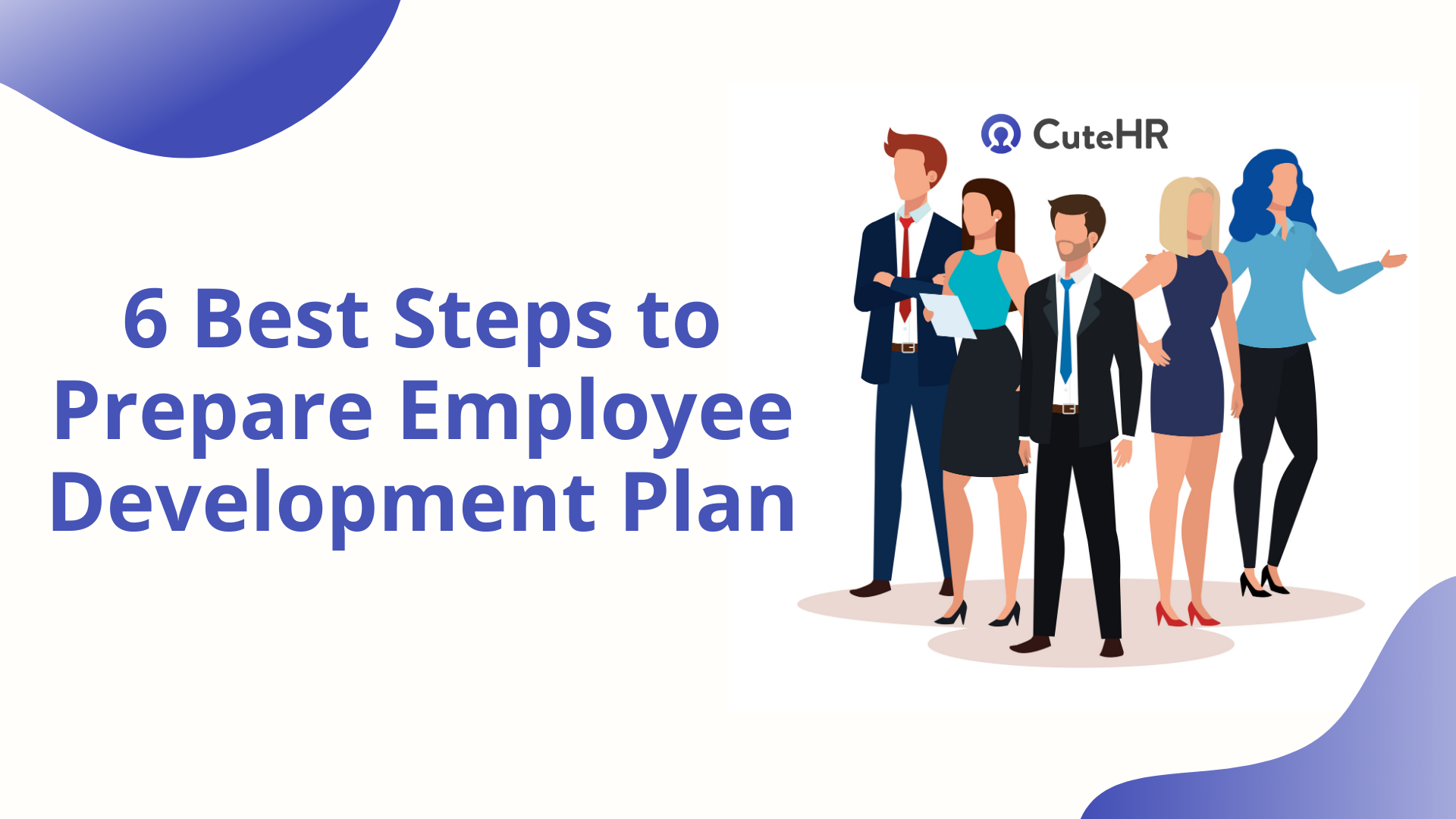
Employees make up a company’s workforce. When a competent staff, equipped with apt knowledge, training and qualifications is hired, they contribute to an organization’s assets. It is detrimental to train these human assets. For the same, an employee development plan can be utilized. Development plans, that nurtures employees, polishes to improve their skills and introduces them to new horizons are needed by the current corporate arena.
93% of employees are inclined to stick with a company that addresses their career development, says LinkedIn’s 2018 Workforce Learning Report.
The primary task of hiring puts a bunch of activities in motion. Management or an HR Department of any organisation should take the new recruits through a rigorous process of growth, training and development. This would ensure that the existing and fresh recruits are up-to-date, alongside aware of the happenings and advances.
“I am convinced that nothing we do is more important than hiring and developing people. At the end of the day, you bet on people not on strategies.”
Lawrence Bossidy: American author and retired businessman
In the corporate sector and otherwise, the importance of onboarding programs, training, and orientations cannot be stressed enough. The same way, there is a bundle of reasons that makes it mandatory to bring an employee development plan into action. The responsibility to a device such a development plan falls with the HRM. It is this department that creates a customised plan with a careful study of each employee skills, marks their progress and fallbacks. For this reason and many others, the personnel of the HR Department are popularly called learning and development professionals too.
An enthusiastic and effective human resource department would bring about such a program; most definitely beneficial for the company in the long run.
Table of Contents
Employee Development Explained
The process of moulding, refining and improving the existing skills of employees, quite simply explains employee development plan. It is this development plan that accentuates the inner potentialities by honing employee skills and introducing them to new ones.
Organizations that build such plans are able to successfully add value to the persisting talent, but through correct training and exposure are also able to acquaint them to new ones too.
Research regards employee training and development as the most esteemed employee benefit. Working with powerful coaches and mentors was a choice of 98% of the surveyed. They considered it necessary for their development.
Employee development plans are key to success. Each company or organisation that invests in its employee growth rather than focusing on competition will have a competitive edge in the market. Developing talent is the only thing that will yield positive results. It is the human resources department in any organization leads and makes an effort in this direction.
Report by Grand View Research Inc. shows that the global HR industry will touch $30 Billion by 2025.
This rise in the demand for the HR industry is due to the stellar employee handling and management it provides. Not only this, it is taking on more and more tasks by efficiently handling the workforce and company demands.
Organizations worldwide, with their HRM, build up strategic tools. Something that adds value, affects growth and boosts productivity is a great tool if brought to it’s best usage.
With the growing technological advancements and the challenges that it comes along with, using a training and development tool will most definitely prove beneficial. A universally accepted potent tool like such has an extremely simple approach and a motive to constantly upgrade and improve. This is possible only when :
- Employee talents are recognized
- Workforce skills are deeply analyzed.
- Effective training is in practice.
- Modern approaches are made use by the HR department
- Company dynamics, metrics, standards, job demands communication, legality related issues and other sensitive topics are conveyed.
- There are effective guidelines that aid in devising plans.
With all these best practices already existing, it becomes easier to introduce and manage an employee discount plan.
Benefits of Employee Development Program
It is agreeable that an effective and functioning employee development program is not only favourable for employees, but for the company as a whole too. To fill in any gaps that can hold back an employee or the entire organization from utilizing resources, the employee development plans render useful enough.
In keeping with the ideal long term goals, all leaders, managers and supervisors must see to the successful implementation of development programs. A long term initiative like such will certainly provide visible short term benefits too. Hence, each development program is built with an in-depth analysis of the company, employees and their combined demands is an amalgam and integration of appropriate activities and see to the needs of the organization. Apart from this, building up such plans can bring about more transparency.
Here the 70/20/10 rule must be applied. Where 70% comes from on the job experience, 20% from other employees or colleagues and the final 10% from training and development.
With HRM stationed in organizations worldwide, erecting such development plans have become the need of the hour. It is high time that along with all conglomerates and company giants, even the smallest of organizations see the groundbreaking changes that such development plans can have on the workforce.
Factors Contributing to Employee Development Plans
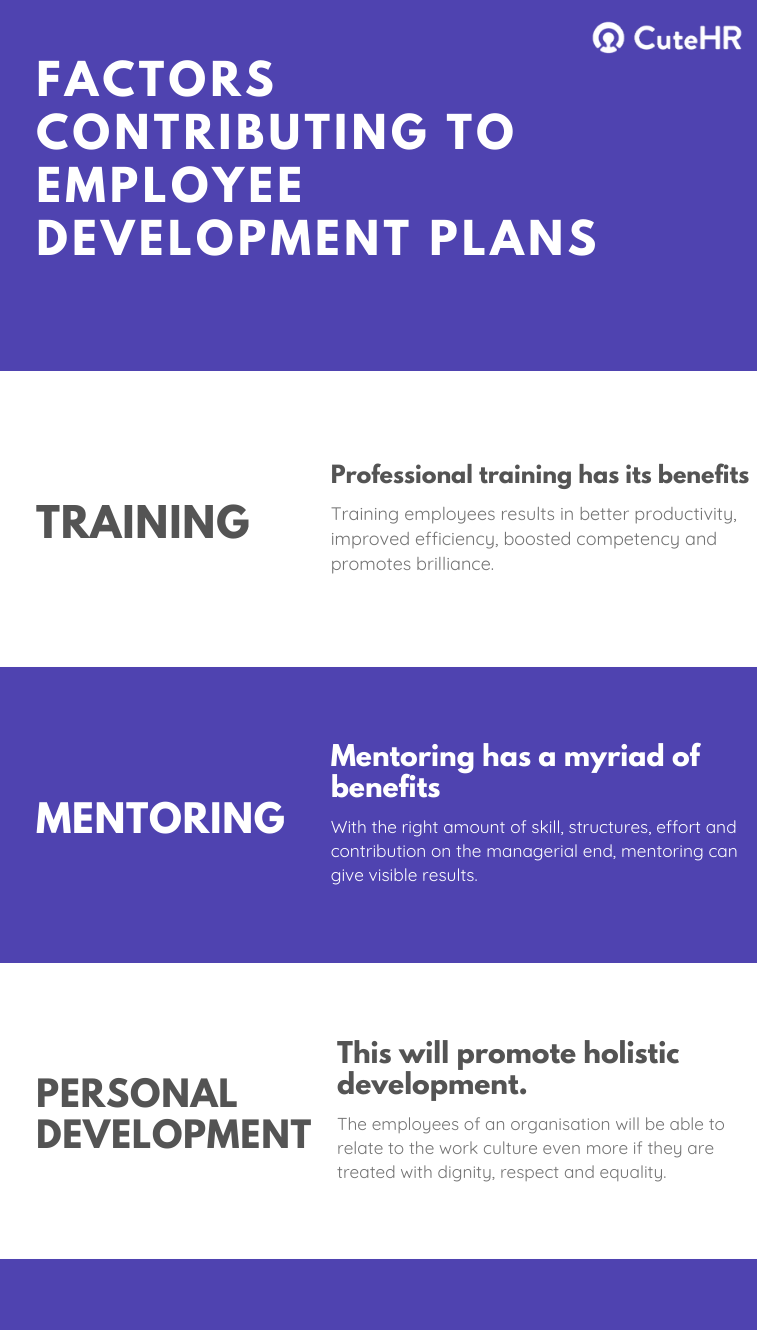
Those ample strategies, policies and plans of action, organizations adopt will be incomplete if there isn’t a well-structured development plan in the cards. Along with endless initiatives, there ought to be measured for the growth and progress of the employees. Employee development plans have the capacity to provide stellar results and lead to magnified productivity.
Companies can frame a better employee development plan, if they keep the following in mind –
1. Training
Not only for onboarding, but professional training also has its benefits and usages spanning across various spheres. Training employees results in better productivity, improved efficiency, boosted competency and promotes brilliance. A key function of the HR department is to pass on all the important information and explain all the essential processes of their company to each new hire. But such training renders unfruitful for the experienced or candidates above entry-level.
To polish such executives and professionals, an acceptable practical approach would be to build a development plan. Such a plan will introduce them to business books, provide e-learning, including webinars and seminars that will encompass various market strategies, trends, popular places and much more.
Report from a survey by the Conference Board depicts that;
Only a staggering 33% of employees in the U.S. content with the training and educational programs that they received.
2. Mentoring
Mentoring has a myriad of benefits. A whopping 71% of Fortune 500 companies make use of mentoring programs to impart better employee guidance.
With the right amount of skill, structures, effort and contribution on the managerial end, mentoring can give visible results. The mentor and mentee relationship can cause learning and growth in a guided and safe manner.
By simply interacting with employees, organisations can find out the problems and provide practical solutions for coaching if needed. Such coaching or training coming from skilled managers provide for better learning opportunities.
3. Personal Development
The employees of an organisation will be able to relate to the work culture even more if they are treated with dignity, respect and equality. An add-on will be if the organisation showed just the right amount of interest in their personal development too. Apart from developing professional competence, the employee development plans must entail features that nurture their personal growth as well.
This will promote holistic development. Supportive management that looks after intellectual growth, providing emotional balance by looking after employees physical health, broadly encompass the demands of today’s workforce. Just simply grooming employees to fulfil the job demand will not lead to retention.
Whenever an organisation is involved in the process of concocting an employee development plan, it must keep in mind the expectations of the workforce. A well-blended combination of this with company values would be ideal. Especially, in such a way that would make the new and existing employees feel valued and worthy.
Benefits of Employee Development Plan
The necessity of an employee development plan cannot be ignored by organisations at any cost. Active, interested and participatory employees not only provide better results but give shape to a much evolved, efficient, well rounded and competitive work environment.
As per State of the Global Workforce (2017) by Gallup, keen and dedicated employees contribute to a 41% reduced absenteeism and deliver 17% more productivity.
The benefits of training and development in a worksphere are vast and long term. The following are the reasons why such development plans are contributive and essential –
1. Increases Employee Retention
A major challenge that all organisations face is on how to reduce their employee turnover rate? These retention rates are to be positively impacted so that the maximum number of employees are willing to stick with the organization. The idea is to adopt such measures and techniques that allow for a maximum number of employees to stick with the company. Career development plans can become a tool for employers. As a competitive edge, these career development plans can become a weapon to increase retention rate.
Research by
‘State of the Global Workforce’ by Gallup, shows that those businesses that have a participative workforce has 59% lower turnover rate.
President and CEO of iHire, Steve Flook opines that, “The possibility that a more rewarding career opportunity is out there is often too compelling for even the most tenured and loyal employee. That’s why employers need to make the extra effort to keep their best talent engaged, nurture staff’s professional and personal growth, and establish a workplace culture that cannot be found anywhere else.”
2. Promotes Employee Engagement
Without a doubt, the employee development plan is crucial to building important skills and tools. Not only this, such plans promote engagement and involvement of the workforce. Consequently, this inculcates a feeling of belongingness and participation.
Training and development plans like such will be helpful in establishing a relationship between the employees and the company. Regular training programs, reevaluation and timely updation will keep a check on all the skills and processes. Besides this, careful and well-structured planning will pave the way towards success and study growth, existing talent and all the internal/external opportunities.
Accessible, independent programs that allow each employee to develop and learn at his own pace leads to a diverse, proficient and competent workforce.
3. Leads Employee Empowerment
As per Udemy’s 2018 Millennials at Work Report, millennials feel valued when their skills are regularly polished, updated and valued. Plus it hints that a decent amount of flexibility is an added perk.
Employees are more productive when they are valued and feel empowered. Not only the workforce, the managers and leaders who feel empowered, greatly influence others and are able to successfully gain trust.
Besides giving value to employees’ opinion, involving the workforce in decision making, taking their opinion for the learning and development (L&D) work promotes autonomy. Consequently, employees feel more powerful and empowered. Finding by Forbes reveals that those employees who feel their voices are heard, consider themselves 4.6 times more empowered and will put in their best effort.
4. Improves Performance
Along with learning and development comes proficiency. This will help produce quality work of par excellence, as per company requirements. It is up to the creators and managers to erect such an employee development plan that plays along the boundaries of business goals. To impart a much deeper understanding of the job at hand, it is training and development that plays a major role. Not only this, confidence is a key element that develops as a result. This mixed with better understanding, motivation and approval is just the thing that an organization needs.
An HR Survey, Jumpstart found that all jobseekers demanded growth and development (professional and personal) from their employers. Millennials also feel the same and hunt for similar expansion opportunities.
5. Promotes Learning By Addressing Weaknesses
The workforce of today demands their company to invest in them. Investment in the form of skill updation, learning and mastery fall in this domain. By utilising an employee development plan that satisfies employees’ needs and equips to upgrade their skills, will work as a boon. Both the organization and its employees can reap its benefits.
The Human Resource Department by making use of analysis and observation can spot skill gaps this way too. These gaps can be addressed easily by bringing in action a development plan. This way, the shortage of skills can be dealt with. As per SHRM skills gap research, there were 83% HR managers who faced difficulty in the recruitment process. From this 75% attributed to the candidate’s shortage of skills as a key problem.
For solving such weaknesses, it is training that can become handy. But for the existing workforce, it is the development and learning programs that prove beneficial. To rebuild broken talent in such a way with also help the company to adjust with the changing times.
6. Brings Evolution By Allowing To Adapt
Organisations that are continuously evolving, learning and open themselves to new opportunities and methods, flourish and succeed. The demand for the ever-changing business structure is to build plans and strategies with flexibility. Employee training and development, which introduces them to new findings, methods or techniques will always provide the company with a competitive edge. For the employees, this also successfully promotes a feeling of being valued. Consequently, this creates an environment of autonomy and democracy.
Creating An Employee Development Plan
By now, the need for an effective training and development plan would seem like a pressing matter. In fact, the simple step of building similar plans can do major good for the company, as outlined by the above set of benefits. To integrate development by including advanced planning programs into the organization will result into fruitful strategizing. This way, programs will stir the company in the right direction.
An easy method for creating an employee development plan is to consider the following criteria –
- Knowledge of Skills – Be it managers or HR personnel, whoever is creating an employee development plan, or is contributing to it must know their employees’ skills. Know the strengths and weaknesses of your workforce. Assess their skills to develop such tactics, which when combined with an employee development plan will lead to professional efficiency.
- Ascertain Goals – Just sticking to the company goals and leaving your employees aspirations behind is not an ideal practice. It will prove to be a hindrance in achieving holistic growth. It is necessary to tag along with all those goals that employees have set for themselves too. The HR best practices and their various tools can be brought to use here. It is only through conversation and understanding that employees’ hopes, demands and aspirations can be unveiled. A perfect concoction of both company and employee personal goals is the desired path to take.
- Enquire and Listen – Being attentive to the needs of employees and alongside giving them due importance are the primary duties of an HR department Making use of feedback can be useful. Survey Analytics shows that companies making use of employee feedback witness 14.9% lower turnover rate.
Besides focusing just on the company goals, treating all employees as equal and being diligent to their wants will be useful.
Things To Include In Employee Development Plan
There are certain key elements that all companies must make use in their employee development plans. The following items must definitely be included –
Step 1- Mix Personal Employee Goals And Company Goals
This should be the primary step when creating a workforce training and development program. It will create a much better and lucrative impression on the employees. As mentioned above, a company should definitely mix and create a good balance of growth-oriented, relationship-oriented and skills oriented goals.
Most importantly, employees must find this development plan relatable and useful in executing daily activities.
Step 2- Study Your Needs
It’s crucial to develop a growth plan for your employees that revolves and caters to the needs of your company. Study talent, skills, identify gaps, and give birth to a strategy accordingly. As a company, you must raise questions on
- how to reduce turnover,
- how to attract talent,
- how to increase employee satisfaction and
- how to keep up with the changing times.
It is needed that training and development plans go in accordance with the company goals to meet all the demands strategically. HR departments of the company make use of the feedback, questions and answers to erect such an employee development plan that is potent enough to deliver results in a similar fashion.
Step 3- Be Employee Specific
The idea behind training and development is to improve employee skills in a manner that they combine together to contribute to the organization’s objectives. An ideal way to start this is by focussing on one employee at a time. Proceeding with one employee at a time will provide for better attention and individualized focus. This will lead to better plan customization. Consequently, producing superior results.
Both the superior and the individual employee has to be on the same page to execute the development plan. Each employee must be dedicated to learn and take responsibility and be participative of the career development plan. Enough research and training must go into it too. Here communication plays a major role.
Step 4- Bring the Appropriate Opportunities
After figuring out what employees want and expect from the organization, the next step is to acquaint them to new opportunities. The most appropriate way would be to introduce them to a list of resources. Here collaborating can be extremely beneficial.
Various sources and methods like the usage of coaching, mentoring, job shadowing, assignments, job rotation and enrichment programs can be made use of.
With the usage of technology, grabbing opportunities to learn and grow have become even more achievable. Utilization of ebooks, webinars, online classes, quizzes, videos and podcasts is extremely judicious nowadays.
Here the team that is building the training and development program must only extend support that the company allows or is capable of giving. Making over the top promises just to lure in employees is an unhealthy practice.
Step 5- Build Effective Strategies
Without a doubt, effective strategizing contributes to increased profits and leads to the pavement of a better program all in all. Strategies can be polished and moulded in a much better manner if the results and feedbacks are also infused into them.
This is specifically the HR department’s job to find and fuse the necessary information while making strategies.
A thing to remember is that company strategies will be completely different from individual employee strategies.
The HR personnel, managers, supervisors and team leaders must be in touch with the workforce to find out what problems their workforce faces, their prevailing thought processes and the accomplishments they have made so far.
Step 6- Analyze Results And Update
An employee development plan is a potent tool to provide the necessary training to the workforce. It is key in developing a good reputation and increasing turnover too. The results that training program yields can be collected to form future strategies and policies accordingly.
However, such programs need regular updation and revision. They render useless after a certain period of time. It is recommended that such programs must necessarily be updated and flexible enough to adapt to changes too.
An employee development plan must consider the need of the employees, address skill gaps and transforms potential employees into efficient workers. Alongside adhering to the company demands, there has to be a continuous learning approach too. A work culture where the main goal is to promote, motivate and encourage the employees to be the best version of themselves is ideal and highly sought after.
Giving employees the freedom to choose any field or a skill they want to pursue and polish promotes autonomy and sends a message of empowerment. Similarly, incorporating employee ideas, making use of their suggestions and valuing their take on things will promote transparency.
Conclusion On Employee Development Plan
It is crucial for company management and organizations to create an employee development plan that will fulfil the needs of training and development. This can have a big positive impact on the company and the workforce. It has the potential to create employees as per the demands of the company and the changing times. With the correct foundation, the presence of a well-structured employee development plan will help to shape up a well-collaborated team of efficient, most importantly satisfied workers.
Companies investing in an employee training and development program will create a win-win situation for themselves. This way both professional and personal growth can be met. Nurturing employees this way would absolutely produce long term desired results.



With Flair in Human Resource study and an Avid HR Reader, Writing and traveling are food for her soul. She is currently studying French at Alliance Française de Delhi. Avneet has also done double bachelors in English Honours and Education.
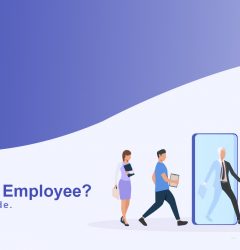
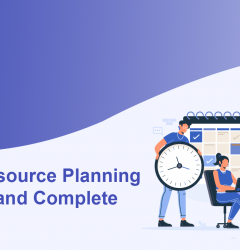
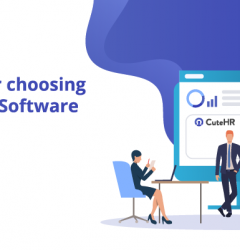









Avneet Oberoi